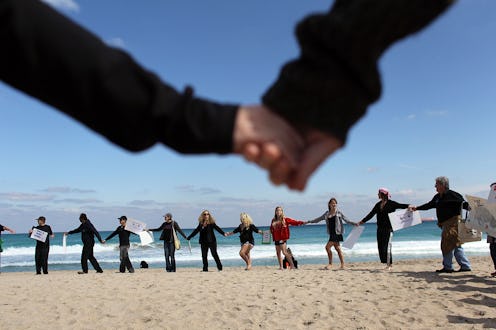News
Trump's Offshore Drilling Plan Is Open To Public Comment

According to a new plan from Trump's Interior Ministry, the country's Atlantic and Arctic coasts could be opened up to drilling, overturning a five-year ban on drilling put in place by President Obama. But for those worried about the environment, the Deepwater Horizon oil spill is proof enough that drilling has the potential to damage the Earth. To make matters worse, drilling could begin just about anywhere along an American coast where oil deposits are thought to be found. Fortunately, there are ways to protest Trump's offshore drilling plan if you think it will be devastating to America's coasts. Moreover, you can do it through an official channel now that the administration has opened the plan up to public comment.
The president addressed the new plan at the U.S. Energy Department last Thursday:
In order to unlock more energy from the 94 percent of offshore land closed to development, under the previous administration, so much of our land was closed to development. We're opening it up, the right areas, but we're opening it up — we’re creating a new offshore oil and gas leasing program. America will be allowed to access the vast energy wealth located right off our shores. And this is all just the beginning — believe me.
For Trump, opening up the seas of America's coasts to oil drilling is just the beginning. So forget about the Paris climate agreement and new clean jobs. Here's how you can protest this decision.
1) Call Secretary Of The Interior Ryan Zinke
This might sound silly, but this is all coming from the Interior Department, and he is the man in charge. Call the department and ask for him, submit online comments too. Snail mail works, of course. But whatever you do, keep addressing him personally. Put a face to this disaster of a policy, and let him know what you think.
2) Sign A Petition
Some of the petitions are local, like this one for North Carolina's coast, but even more are against the entire Trump drilling agenda.
3) File A Public Comment
Even more important than a petition, though, are the public comments that Americans can leave with the Federal Register. You have until Aug. 17, so take time to prepare them well. See if you can organize a community or environmental group to make a submission together.
But don't be afraid to submit one personally. The Bureau of Ocean Energy Management "invites all private and public stakeholders, as well as the general public, to comment or provide any information that they believe should be taken into consideration." That means you.
4) Call Your Senators
Sen. Jeff Merkley gets it, but we need all senators, especially in effected states to be this vocal on the plan. Find their local and D.C. offices and call.
5) Find Your Representative In Person
Now that it's summer, your representatives will likely be in their home district more often than not. That's true this week around July 4, but also all of August. Attend any public meetings they have, and let them know how you feel about this plan. Town halls have been hard to come by, but there are other opportunities.
6) Write A Letter To The Editor
Change the conversation in your local communities by writing a letter to the editor that explain your views on the area. Many letters written by everyday Americans could have more influence than even Al Gore writing in The New York Times.
7) Pressure The Oil Companies
The other thing to take into consideration is that the government can only open up the sea floor to drilling. That doesn't mean that it will necessarily be drilled. Private companies would need to get in on the action. Make sure they don't by keeping up social media pressure on the giants. Shell pulled out of the Arctic — make sure that no one else takes their place. That should be relatively easy if the price of oil remains depressed. But be prepared for a rise.
Once you have taken all these steps, there's a chance the Trump Administration will either ignore your calls or take them into consideration and stop the plan. Either way, it's never too early to get mobilized and start building networks for change, even if they aren't immediately successful.